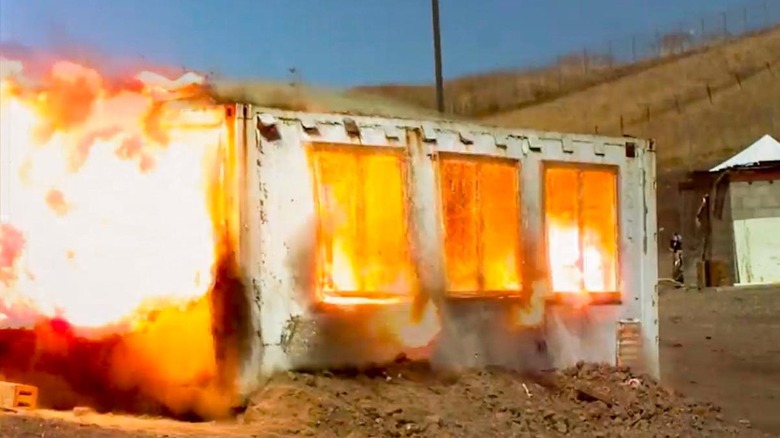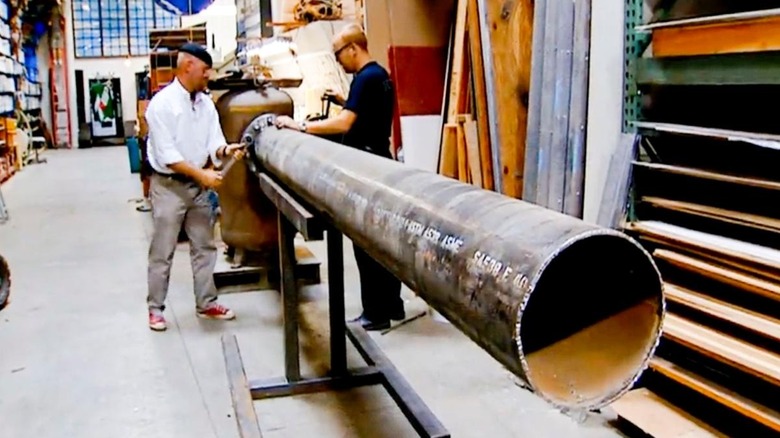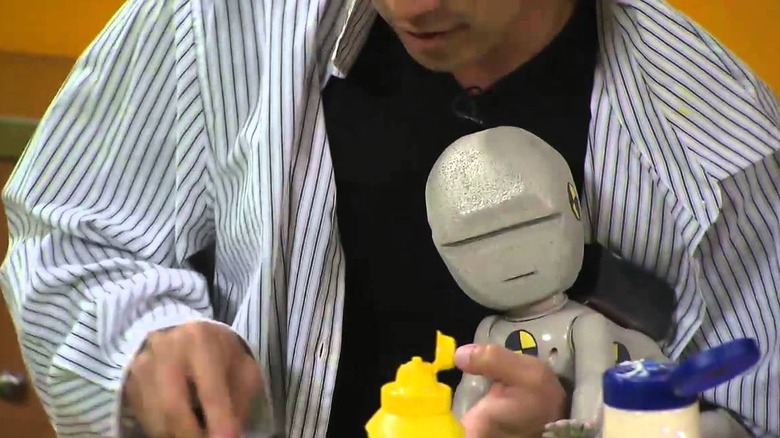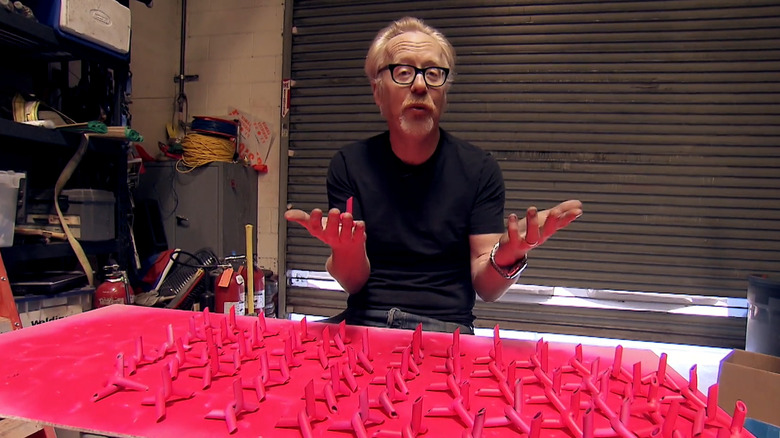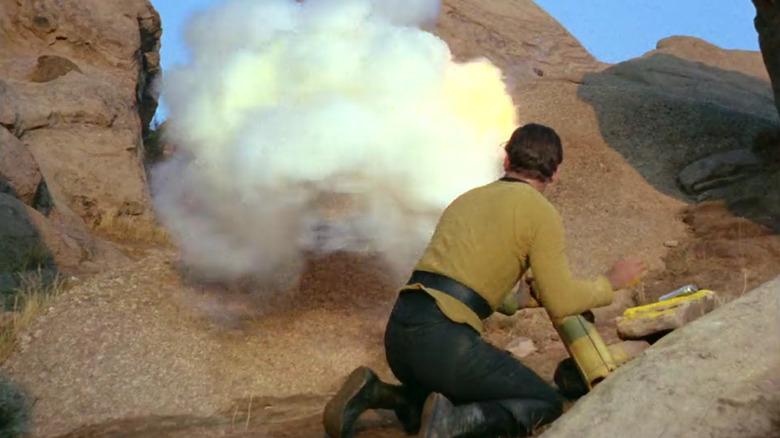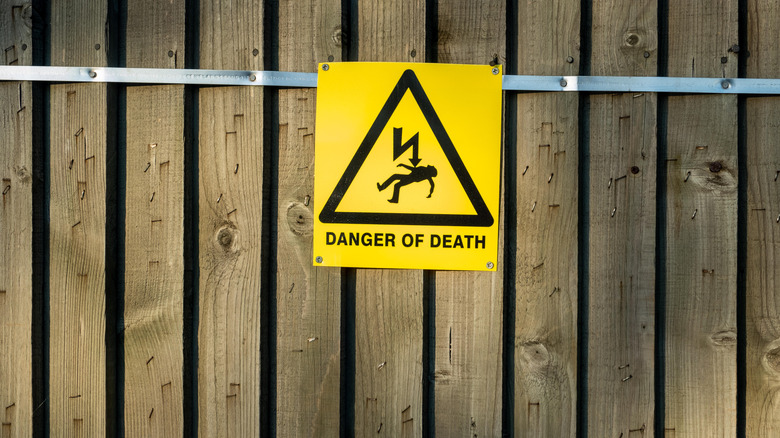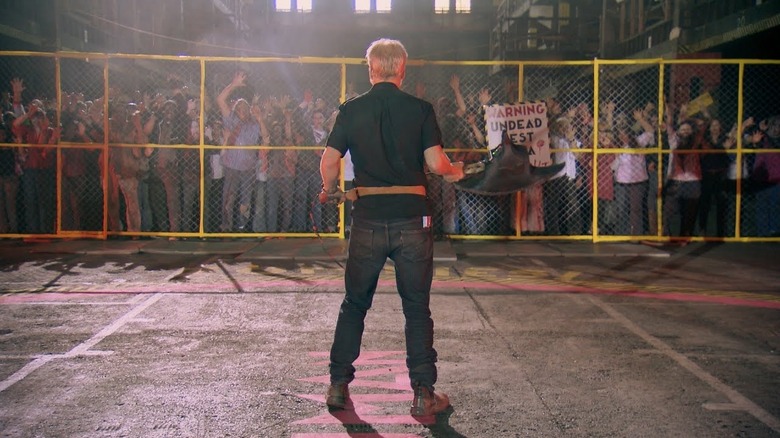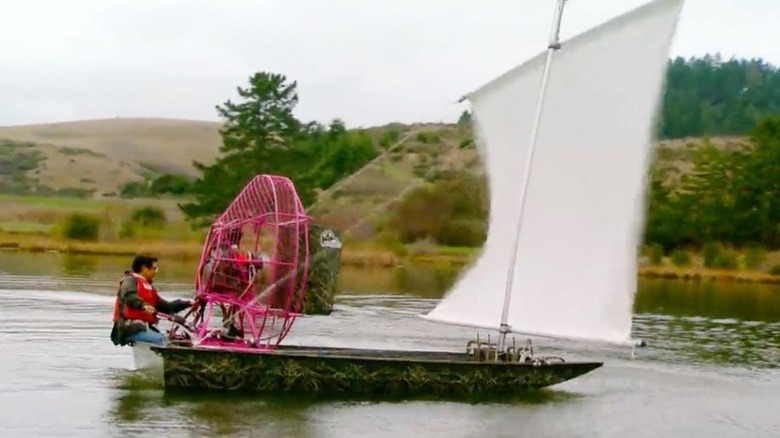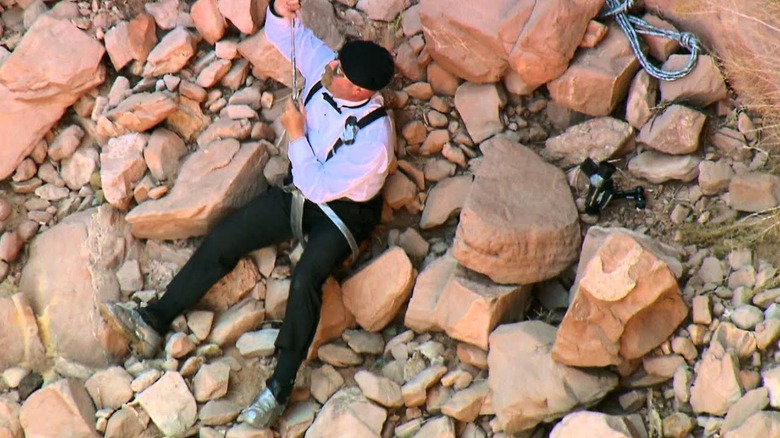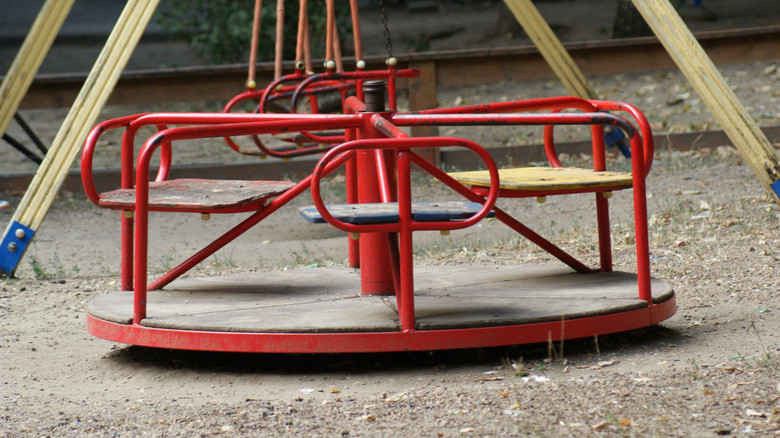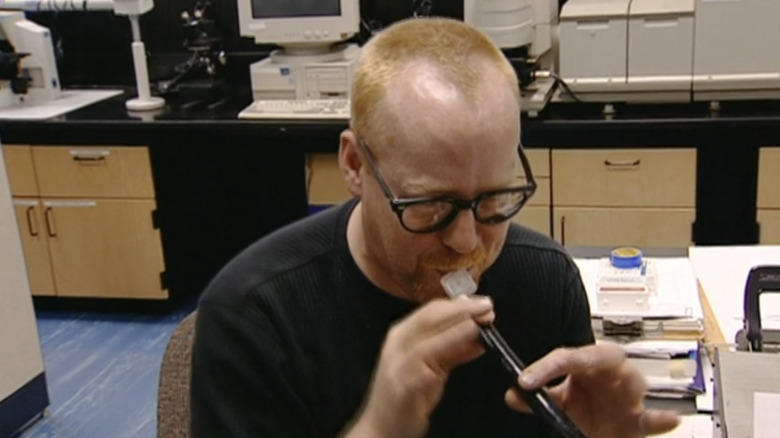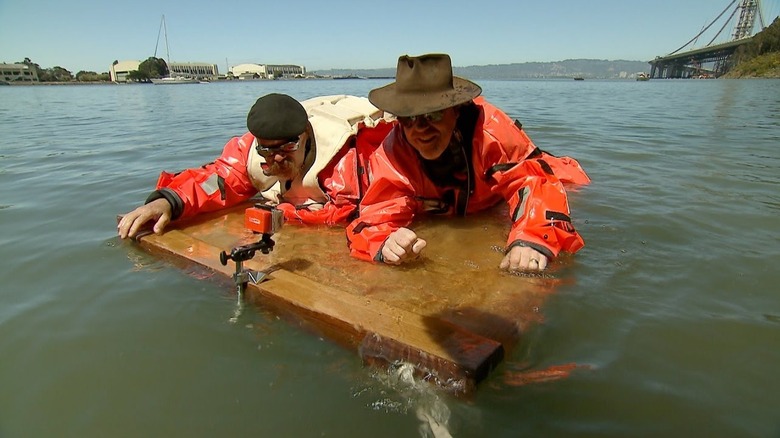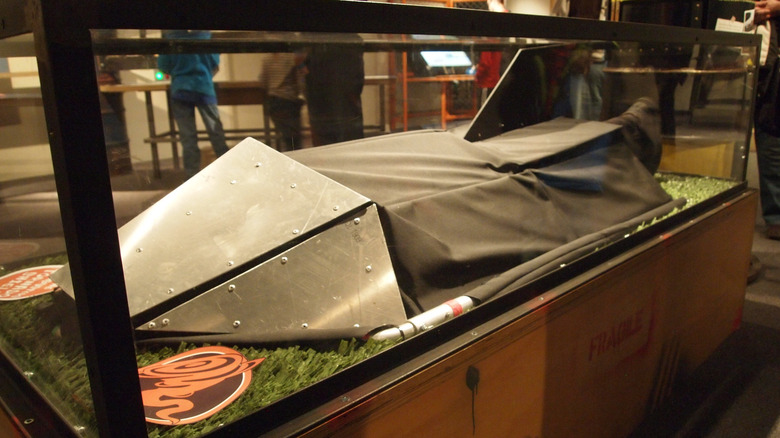Things MythBusters Actually Got Wrong
Before getting into anything else, let's be as clear as possible: Yes, obviously part of the untold truth of "MythBusters" was that it was always meant to be entertainment. No one reasonably expected hosts Adam Savage and Jamie Hyneman (or Build Team members Kari Byron, Grant Imahara, and Tory Belleci) to be publishing their sometimes rather dangerous results in a peer-reviewed journal. It's also true that, over the course of the show's 14 seasons (not including a 15th season with new hosts) the team often put in real scientific work, with all manner of calculations, small-scale testing, and interesting findings in plain view up on the screen. Indeed, they weren't all that far off base in many conclusions, even if their sample sizes were low and some episodes got a bit gimmicky or odd. Most times, the MythBusters were clearly having a lot of fun.
But they weren't always correct. Some tests have become practically legendary for getting it wrong, with fans from the couch to the White House haranguing the MythBusters about the details of the Archimedes death ray or getting all wrapped up in the finer points of a hastily constructed "Star Trek" cannon. Even less-flashy myths tested on the series occasionally came up for debate. Whether the culprit was a misplaced decimal, the ever-present pressure of budget and filming schedules, or just pure mistake, we have to admit that the MythBusters sometimes got stuff wrong.
The Operation Valkyrie test had some big flaws
Operation Valkyrie, which inspired the "Valkyrie" movie and involved an attempt to kill Hitler via bomb on July 20, 1944, was the result of months of growing discontent, which generated the idea (championed by some high-level Nazis) that taking Hitler out would help Germany recover politically, militarily, and morally. Colonel Claus von Stauffenberg was selected to do the actual bomb-delivering to a command center in Poland known as Wolfsschanze (Wolf's Lair). Stauffenberg meant to leave an explosive-laden suitcase beneath a meeting table, in an underground bunker and as close to Hitler as possible. But the summertime meeting was moved to an above-ground structure with better circulation, only one explosive was armed, and someone unwittingly moved it away from Hitler. The bomb went off and killed four, but Hitler survived.
The MythBusters attempted to recreate the explosion in an above-ground bunker and an underground one. Would Hitler have been killed by a pressure wave in a reinforced subterranean space? Initial tests suggested that was the case, but a full-scale test, complete with a styrofoam Führer meant to catch shrapnel, showed he could have survived.
Viewers quickly identified some issues. The team used metal shipping containers, one of which began to collapse as it was buried and had to be hurriedly replaced and half-covered. That container was "sealed" with a pile of wood railroad ties. Others argued that shipping containers weren't great analogues for the deeper, multi-room complex in Wolfsschanze.
The chicken gun was controversial
If you're going to talk about controversial "MythBuster" results, there's no getting around the chicken gun. This is actually a longstanding technique and device used by multiple agencies to test bird strike impacts on aircraft, generally relying on a cannon-like contraption powered by compressed air and delivering high-speed payloads of foam, other materials, or even actual chickens to test the impact resistance of various aircraft materials. All of that makes this a prime testing target for the MythBusters, who initially took on the chicken gun in a 2004 episode. The question: Was a frozen chicken more damaging than a thawed one? At the time, they found that thawed birds were just as destructive as their frozen counterparts, giving the myth a stamp of "busted."
But, things got tricky ... so tricky, in fact, that the MythBusters revisited it in an episode that aired just months later. The major problem was that, in the original test, Adam, Jamie, and the rest of the team hadn't used genuine airline-level glass meant to better withstand such strikes and other forces. Though they didn't get another small airplane cockpit set up, they did approach the problem from another angle. This time, they used multiple panes of glass and, upon firing the chicken gun at the target, counted how many broke in each attempt. Their conclusion? They were wrong the first time around. With further consideration, the myth became "plausible."
Bumpers can explode, but details get thorny
Under the right conditions, can a car bumper explode? Well, yes — but how far will it fly? We do have reasonably reliable accounts of pressurized car bumpers taking short flights under certain conditions, such as when a car fire generates heat and extra pressure inside parts like a bumper's shock absorbers. This isn't really even a myth, as firefighters have occasionally witnessed (and documented) such a thing happening. The MythBusters themselves more or less confirmed it in an episode when they interviewed a firefighter who was injured when an airborne bumper hit her legs while her crew was attending to a car fire.
But, Adam and Jamie wanted to get more specific. Okay, bumpers equipped with pressurized components like shock absorbers can shoot off during car fires — but can one go the distance? That is, can it fly 50 feet, as some tales would have it? They were unable to produce such dramatic results in their tests, causing the two to conclude that the myth was busted.
To some, the 50-foot benchmark may have seemed arbitrary or even unnecessarily restrictive. Does hitting that specific data point really matter when the original myth wasn't necessarily calling for a bumper to be flung a house or two down a residential street? Some have since argued that the MythBusters got it mostly wrong by focusing so much on those 50 feet and instead should change their "busted" judgment to a more accurate "plausible."
The right kind of car might still lift a manhole cover
Back in 2013, the MythBusters aired an entire special dedicated to Indy cars. One involved the myth that, in a road race, a sufficiently fast vehicle can create enough force to lift heavy manhole covers up from the road. With the help of racer Logan Gomez and a weighted plastic cover, they tested the myth. Though a slimmed-down cover did slightly budge when Gomez drove over it at speeds exceeding 100 miles per hour, the MythBusters nevertheless called the whole thing busted.
But the physics involved indicate that it might still be possible under just the right conditions. That's because a car isn't really pulling the manhole cover up, but reducing the air pressure on top. This allows air below to push upward and perhaps move the cover. With enough of that pressure beneath and a sufficiently fast car atop to sweep away air pressure, it could theoretically happen.
Of course, that would still be pretty tough in the real world, as we're talking about speeds in excess of 400 miles per hour. But maybe there's another answer in the form of Formula 1 cars. These mega-fast vehicles may not get quite so speedy (they've topped out at just over 234 miles per hour), but are designed to maximize ground effect — essentially, keeping atmospheric pressure beneath the car as close to zero as possible. Maybe, just maybe, a different car could get closer to overturning that busted verdict.
The gender-based multitasking myth skipped some things
The MythBusters often engaged in testing cultural myths, leading to not just one, but two gender-based specials deemed the "Battle of the Sexes." But even these contained possible missteps, like "Battle of the Sexes: Round 2," specifically the segment in which the Build Team evaluated the idea that women are better multitaskers. A group of 20 volunteers (10 women and 10 men) was tasked with individually facing a busy morning in which they were asked to simultaneously complete tasks like taking a business call, getting dressed, making breakfast, and managing a wily robot baby. With a starting score of 100, points were knocked off for every failure. The women averaged out at 72, while the men achieved an average 64.
Yet, academic research is less clear, as when a 2021 study published in the Quarterly Journal of Experimental Psychology found no real difference when it came to sequential multitasking, with men performing slightly better on concurrent multitasking similar to the type tested on the "MythBusters" episode. But different types of multitasking were better for different genders, while it's possible that individual abilities independent of one's gender came into play as well. A 2013 study in BMC Psychology found similar weak results but cautioned anyone against making broad conclusions, while a 2019 paper in PLoS One found no real difference at all (other than concluding that pretty much no one was very good at multitasking, regardless of gender).
Road spikes rang hollow
Road spikes might seem like a for-sure tactic in spy movies involving a dramatic car chase, but would they truly stop a car in a real-world pursuit? That was the question in the 2010 "MythBusters" episode "Spy Car Escape." While in a mock chase, Adam, in the lead car, deployed a scattering of wicked-looking road spikes. While the pursuing car took some damage, it didn't take effect quickly enough, and Adam was caught. The team concluded that the solid spikes helped to keep air in the tires.
In 2015, "MythBusters" was on the case again in "Unfinished Business," yet another episode in which they gamely addressed viewer feedback about past myths. This time, Adam put together 50 revamped road spikes made from hollow tubes and painted a fetching neon pink to show up against the road. Just like the previous, solid spikes, these were constructed of two 90-degree segments welded together, a tetrahedral arrangement that meant, no matter how the spikes were deployed, one pointy end would always land facing up to puncture a tire.
And indeed the new spikes punched holes in a tire, and pretty dramatically, too. This time, Adam was in the pursuit vehicle while Jamie deployed the spikes. Within mere seconds, all four of his vehicle's tires were flat and even coming away from the rims, making driving all but impossible. This time around, the MythBusters admitted they had gotten it wrong and gave the myth a new verdict of "confirmed."
The Gorn cannon got Trekkies involved
Seen in the 1967 "Star Trek: The Original Series" episode "Arena," the so-called "Gorn cannon" appears after Captain Kirk is transported down to a desolate planet to face off against the lizard-like Gorn captain. (An interceding species, the Metron, has determined the two need to solve their differences in a one-on-one faceoff.) After a few rounds of tussling, Kirk manages to assemble a cannon with what looks like a large bamboo tube, some rope, explosive minerals, and a few spare diamonds he's found lying around. He fires, shows mercy to the downed Gorn, and manages to get back to the Enterprise more or less unscathed.
The Build Team built their own "Star Trek" cannon in 2009's "Mini Myth Mayhem" episode. Using bamboo, rope, and homemade gunpowder, they fired it with sobering results. While the Gorn stand-in was fine, the Kirk analogue was decidedly down for the count. A second test with a reinforced barrel was even worse. The Build Team concluded that the myth was busted.
But was it, really? Swiss chemist Ulrich Bretscher did a bit of digging and concluded that Kirk's ersatz gunpowder recipe could work, assuming he'd gotten the right sort of charcoal (perhaps better than what the Build Team used), mixed it up in the right proportions, and found a particularly strong piece of extraterrestrial bamboo (via Discover). What's more, YouTubers Thrand Godfrey and Eldgrimr Skjaldvegr built their own Gorn cannon and showed that it was possible to fire without the bamboo disintegrating.
The party balloon pile-up could have used more rigorous testing
This weirdly funny myth came up in 2012's "Trench Torpedo," in a segment that tackled the notion that a car packed full of balloons would offer some protection equivalent to an airbag in the event of a crash. Cars were dropped straight down from 41 feet to simulate a 35 mile-per-hour crash; the Build Team established 100 gs of force to be the point at which a crash is no longer survivable. The control, with no balloons for the test dummies (some of whom were buckled in during testing, while others weren't), produced a whopping 630 g force.
During a test in which the car was packed improbably full of balloons (what a party!), the Build Team managed to get that force down to 130 g. Clearly, that exceeded their 100-g line in the sand and the dummies inside were pretty well doomed. Right?
While the team roundly claimed the myth was busted, perhaps the myth could have done with fewer dangling strings. Why didn't they establish what it took for a crash to be survivable? Were there other balloon configurations they could have tried? At the end of the day, they were almost certainly rushed due to tight filming schedules and budget constraints. (The show surely didn't have endless money set aside for paying crane operators and buying scrap-worthy cars.) Still, it may not be totally fair to call this myth definitively tested, much less busted.
Shocking developments in outdoor bathroom breaks
Longtime "MythBusters" fans know about the notion that peeing on the electrified third rail of subway or train tracks could result in a person's deadly electrocution. One of the very earliest episodes of the show had Adam and Jamie setting a more-or-less anatomically correct dummy to stream liquid onto an electrified train rail. It was technically possible, but the steam broke up into separate, non-conducting droplets quickly, meaning a person would have to get laughably close to the rail for the myth to work.
A look at the literature potentially undermines this. Some modern reports indicate that individuals have died while attempting to urinate on the third rail of New York City subway lines, as when 1960s NYC medical examiner Dr. Milton Helpern alleged that a man named Patrick O'Malley, found dead on a subway track with telltale burns on his hand and privates, was killed after just such an occasion (via "Where Death Delights"). However, some of the details concerning O'Malley's Irish heritage and love of alcohol could hint that this tale is discriminatory and at least partially embellished.
The MythBusters themselves called their earlier results into question, though with plenty of changes made to the original myth. In "Myths Revisited," the MythBusters maintained that their electric rail conclusion held, but set up a mini electric fence in the shop. Adam stepped forward and personally learned that a hearty stream and standing close enough would deliver a small but definitely noticeable shock.
Maybe they should give video games more credit
In "Unfinished Business," Adam and Jamie drew upon their previous experiences in the show's "Video Game Special." But instead of breaking out their "Doom" cosplay again, the pair took a more sedate route and decided to play golf. Specifically, Adam and Jamie — neither of whom had ever played golf at that point — decided to see if they could improve their skills. Adam would take one-on-one lessons with a golf pro, while Jamie would practice his swing using a video game setup. Would they improve on their admittedly unimpressive control round? Adam knocked 10 strokes off his control, while Jamie's only improved by two. A deeper look at the mechanics of their golf swings showed marked improvement in Adam's technique, too, while Jamie's apparently lagged. Therefore, the notion that video games might improve your real-world skills was busted.
Only, further research has undermined that conclusion. Anecdotally, numerous professional athletes have said that they use video games to up their skills, from scoping out opponents' tactics in multiplayer games like "FIFA" to more generally working on fast-paced problem-solving. Similarly, a study published in Cognitive Training found that some video games could boost an athlete's adaptability, while others — like a 2014 paper in Human Movement Science and a 2021 study in Procedia Computer Science — showed measurable improvements in coordination, response times, and tracking amongst some gamers.
Does walking in the rain really mean you'll get less wet?
When it starts to rain, is it better to hustle your way indoors, or could stubbornly continuing to walk somehow keep more rain off your body? It sounds almost too obvious to test — surely, running gives raindrops less time to land on you — but the MythBusters took on the problem anyway, with surprising results. In the original test, the MythBusters found that running means you actually take on more water, confirming the notion that it's better to just keep on strolling when a rain shower hits.
However, there were some flaws in this first run-through. Jamie and Adam used an artificial rain device during the test, which many viewers subsequently argued didn't properly replicate the vagaries of a sudden weather event. Sure, Jamie may have initially argued for more controlled conditions, but perhaps that meant they were modifying the conditions too far to get a reliable conclusion (yes, even for TV). Other scientists have certainly come up with different conclusions over the years, including the argument that wind conditions could dramatically affect your choice and outcomes (though you'll still get wet no matter your speed).
As for the MythBusters, they admitted the original test was wonky enough that it required a re-do. In "MythBusters Revisited," they managed to run it again in an actual rainstorm. This time, they saw that running kept a subject somewhat drier than walking, turning their first conclusion on its head.
The zombie myth had some odd details
In the MythBusters "Zombie Special," Adam and Jamie found themselves facing off against a zombie horde. The pair wondered: Is it better to take them out using a gun or an axe? Adam took up a foam-tipped prop axe, while Jamie used a paintball pistol (and approaching zombies — really living volunteers — wore face masks). Adam dispatched an average of 14 undead before he was "bitten," while Jamie managed seven, leading to confirmation for the pro-axe crowd.
To be fair, the duo eventually revisited the myth in the MythBusters "Volunteer Special." Adam used the help of an electronics expert, an accelerometer, other gadgets, a real axe, and a human head analogue to calculate the speed and force necessary for proper skull-cracking. Without the correct force, the axe wouldn't register a "kill" and Adam would have to try again. In the re-test, "zombies" initially got through a small point in a fence, then breached a larger section (as opposed to the original test, where Adam and Jamie were fully surrounded). Adam eventually tired and was overtaken, but Jamie's paintball gun attempt still fell short.
But would a better shot — sorry, Jamie — have a higher success rate? Did their force calculations hold up? After all, research published in the Journal of Neurosurgery found that "catastrophic" skull failure requires about 520 pounds of force ... and we don't precisely know what it would take to knock down a zombie.
Sailing with a fan got the angle wrong
Sailing with a fan is another "MythBusters" escapade that sounds a bit too obvious to warrant an actual test. But, upon putting the idea through its paces on "Blow Your Own Sail," the team found that, you actually can do just that. If you happen to be in a becalmed sailboat, you might just be able to break out a handy (big, big) fan to get things moving again. That's what the Build Team found, though it took some finagling to get a strong fan and big sail to make things move ... and the full-scale test only got a boat to crawl forward at three miles per hour.
However, while the Build Team's "confirmed" verdict wasn't strictly wrong, viewers noted that their technique of pointing the fan straight at the sail may have hampered the results. That's because sails are meant to catch the wind at an angle, which allows the sail to essentially inflate and create a shape similar to an airplane wing. This generates a force not unlike lift, only on a more vertical plane. This is what allows sailing vessels to move into winds, even though it may initially seem as if the crew will have to break out the oars to get anything done. Perhaps that Build Team was yet again hampered by budget or time constraints, but it would have been interesting to see if a few changes of angle got them a more impressive result.
Sorry, we have to talk about the Archimedes death ray
The basic story of this perennial myth hinges on the tale of a "death ray" designed by Greek inventor Archimedes, who is said to have created some sort of glass-based weapon in 212 B.C. that repelled Roman invaders of Syracuse. Most have since concluded that, if it was real, this weapon was some sort of reflective array that would have concentrated the sun's beams into one powerful, potentially fire-starting ray. The MythBusters first tested it in 2004, when they concluded that the mirror would have been comically large and only created a moderately warm spot. They revisited the myth a couple years later, where it was once again busted. The last test came in 2010 at the behest of President Obama and included 500 high school volunteers attempting to coordinate and focus their mirrors onto a mock ship. Yet again: busted.
Case closed, then, right? Well ... the MythBusters were hardly the first to test this concept, and they were certainly not the last. In 2024, Ontario student Brenden Sener made waves with a science experiment in which he used small concave mirrors to focus the rays of a heat lamp onto a miniature target. He found that the temperature of the target increased with the addition of each mirror and suggested that, with larger mirrors and a larger heat source (the sun), ignition would be possible. The Ivanpah Solar Electric Generating System did something very similar in California's Mojave Desert, using computer-controlled beams to precisely track the sun and focus its rays onto receiving towers, though it closed after 11 years as competing solar energy technologies became cheaper.
That duct tape rope isn't precisely fair
The "Duct Tape Canyon" special was already a bit far-fetched, what with the beginning wherein Jamie and Adam, en route to a formal event in their vintage car, break down in the desert. The tuxedoed duo happen to have an inexhaustible supply of duct tape and bubble wrap, which they use to make it back to civilization. That includes surviving chilly nights outdoors and navigating class 5 rapids on custom-built rafts, but the point where fans got tied up concerns rope. Specifically, to get to those rapids, Adam and Jamie rappel down a nasty-looking rock face using custom-made duct tape ropes.
Adam Savage has since clarified they used real climbing rope as a safety backup. That's highly sensible, but the issue perhaps goes deeper. The MythBusters concluded that it was possible to rappel using a duct tape rope (and that they never actively put weight on the backup rope), but fans aren't so sure. Online, some argued that they felt duped by the lack of clarity, as the backup rope was covered in duct tape, too. Others wondered if the way Adam and Jamie were sitting in their harnesses indicated that they were at least sometimes putting weight on the safety. That's speculative, of course, and understanding just how weight was loaded on what rope is difficult to verify from viewing the episode alone. Perhaps, if this were tested in the MythBusters shop with more controlled and obvious results, their claims would land on stronger ground.
The bullet merry-go-round physics was a bit of a mess
In "Mission Impossible Mask," viewers were treated to a segment inspired by the action film "Shoot 'Em Up." In the movie, a character gets a merry-go-round structure on a playground moving by shooting its metal bars. The Build Team set out to determine whether or not this could actually happen, which meant setting up a merry-go-round on a firing range and shooting at it with a series of weapons. Handguns did nothing to spin it, while a shotgun simply blasted a hole through the metal tubing. With metal plates welded to the target, the shotgun also proved lackluster, and the structure didn't move.
The Build Team finally got some movement with the combination of plating and a seriously overpowered AR50 rifle, which moved the merry-go-round ... 8 inches. They finally got it continuously moving with the addition of ball bearings to the play structure and multiple high-powered weapons firing in sequence, but by then the myth was pretty clearly busted.
Well, kind of. It's not that they were precisely wrong about how hard it is to move playground equipment with firepower (or how poorly advised such a thing may be in the first place); it's more that their physics was a bit wonky. In short, while explaining how it all worked, the team got basics like kinetic energy and momentum all mixed up. The results may still stand for themselves, but the wobbly theory undermines the conclusions.
The breathalyzer episode had some intriguing omissions
Can you really defeat a breathalyzer test, even if you're thoroughly in your cups? Probably not — and you definitely shouldn't try. Yet, when the MythBusters took on the supposed myth, keen-eyed viewers noticed some curious exclusions. It all went down in 2003, when an episode featured Adam and Jamie getting soused under police supervision. With a police officer administering a breathalyzer test, they attempted to artificially lower its reading of their blood alcohol levels. These included holding pennies in the mouth, eating an onion, and going hard on the breath mints. Nothing worked, leading to a conclusion of "busted."
But, breathalyzers aren't perfect. They work because the ethanol in your drink gets into your blood and eventually your lungs, where it's expelled on your breath. A breathalyzer uses a beam of infrared light (or fuel gas sensors) to measure that ethanol and determine if you're over the legal blood alcohol limit. However, these devices typically have a wide margin of error that can produce false positives. Any alcohol still in someone's mouth can also boost the reading, even if they've just taken a swig and aren't impaired yet. Certain medical conditions, like diabetes and acid reflux, can also elevate readings. Hyperventilating might just fool the device ... only, the cop would surely notice your weird breathing pattern, and having stupendously high blood alcohol levels will nullify this, too. Ultimately, it's understandable why the MythBusters might have skipped mentioning this, as no one wants to encourage highly irresponsible and dangerous drunk driving.
My Titanic door debate will go on ... and on
If there's one myth that goes beyond even "MythBusters" in terms of cultural cachet, it's one that has to do with a certain door. Specifically, the infamous floating one seen in the climax of James Cameron's 1997 epic, "Titanic." Fans have been arguing for decades as to whether or not Jack and Rose could have both fit on that door and survived. (If you really want to quibble, it's actually a piece of door frame, by the way.)
Naturally, the MythBusters got involved. At the behest of Cameron himself, they began testing the buoyancy of the wood piece, as well as the hypothermia risk. Then, the duo got into their drysuits and took to a local waterway with a replica door frame and one period-accurate life vest. (Jamie played Rose, of course.) On nearly all attempts, they found that Jack was doomed. His only reprieve came when Jamie/Rose took off the life preserver and secured it beneath the door, boosting its buoyancy. The MythBusters found that, under just the right conditions, Jack could have crammed himself onto the door alongside Rose.
Years later, Cameron re-tested the situation in the National Geographic special "Titanic: 25 Years Later." Stunt doubles in a chilly pool found that the life jacket trick was, well, pretty tricky. Cameron found another solution, but he cautioned there were many variables that could make it all go wrong. "Based on what I know today, I would have made the raft smaller," he concluded.
There's a glaring problem with personal tornado shelters
So, what are you supposed to do when a tornado is bearing down on you? If you're a sensible regular person, you take shelter as quickly as you can, ideally inside a sturdy building, on the first floor, and in an interior room away from any windows. But if you're a tornado chaser, or a MythBuster meeting up with one for a good old-fashioned Discovery Channel cross-promotion, you park right in the face of danger. Or, in this case, right in the path of a jet engine's exhaust on "Storm Chasing Myths." Here, the MythBusters took on the idea of personal tornado shelters. Could someone really whip out a shelter and survive an F3 tornado? After small-scale testing, the MythBusters came up with a collapsible affair carried backpack-style. Jamie was confident enough to be the test subject and anchored the shelter in the path of said jet engine. On the first test, the shelter began to peel apart at 135 miles per hour, but a quick redesign and do-over pushed that to 180 miles per hour.
However, that engine only blasted air in one direction. Tornadoes are massively powerful storms that definitely move in a circular pattern. (Just ask the cow from "Twister.") What's more, they can change their overall direction at any time. How would the shelter hold up if the air suddenly began moving from the side? The MythBusters declined to test that and discover what really happens if you get sucked up by a tornado.

